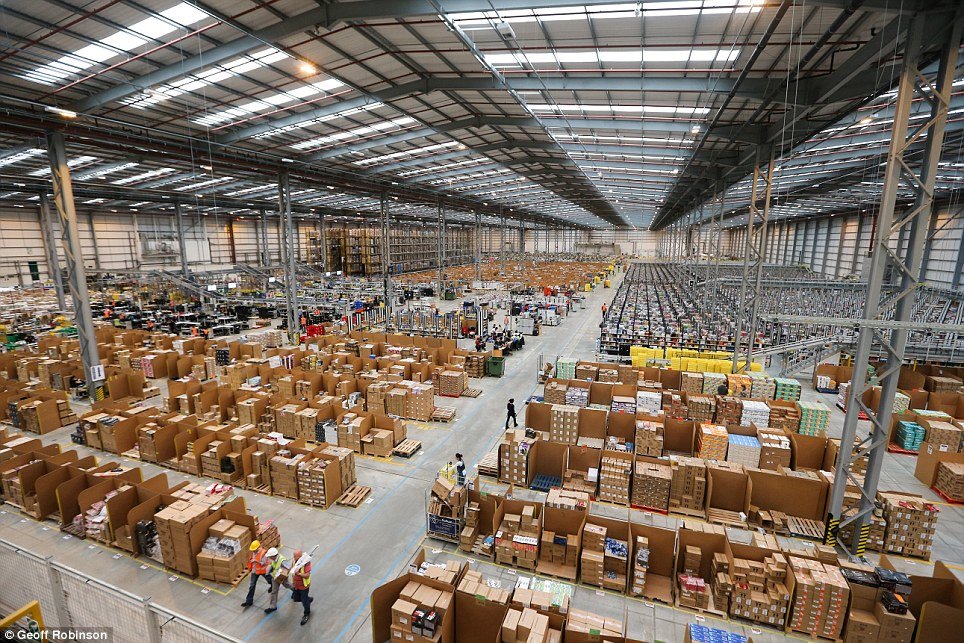Comment: With hourly wages averaging around $12, or less, Amazon's warehouse workers also have to deal with walking 10-20 miles per shift and Orwellian surveillance constantly reminding them 'You are being watched.' It's all completely legal. The American dream...
While waiting to clock in each morning, workers at some Amazon.com warehouses get a steady stream of company-provided reading: the stories of co-workers fired for theft.
In an effort to discourage stealing, Amazon has put up flatscreen TVs that display examples of alleged on-the-job theft, say 11 of the company's current and former warehouse workers and antitheft staff. The alleged offenders aren't identified by name. Each is represented by a black silhouette stamped with the word "terminated" and accompanied by details such as when they stole, what they stole, how much it was worth, and how they got caught—changing an outbound package's address, for example, or stuffing merchandise in their socks. Some of the silhouettes are marked "arrested."
Theft is a persistent concern for Amazon, with warehouses full of small but valuable items and a workforce with high turnover and low pay. Workers interviewed for this story say the range of thefts posted on the screens is as varied as the company's sprawling catalog: DVDs, an iPad, jewelry, a lighter, makeup, a microwave, phone cases, Pop Rocks, video games. Several recall a post about an employee fired for stealing a co-worker's lunch.
The digital bulletin boards also occasionally display information about firings related to workplace violence. There are cheerier announcements, too, such as updates on incentive bonuses or a message about Black History Month. In some warehouses that don't have flatscreens, workers say, tales of firings are posted on sheets of paper tacked to bulletin boards or taped to the wall.
Many workers say their wages or workloads concern them more than the screens
Former managers in Amazon's loss-prevention department say the use of theft stories was widespread during their tenure. Amazon didn't respond to requests for comment for this story.
Many of the workers say the screens aren't a top concern compared with wages or workload. "Only people that would have something to say about it is people that's doing wrong," says Maurice Jones, a warehouse worker who left Amazon in February. "It's just letting people know that you're being watched."
Yet the tales of theft and punishment are hard for workers to ignore—like a car crash, Jones says. "It could be one lane that's blocked, but all the traffic slows down because everyone wants to look at it," he says. "Like, 'Who was stupid this time?' "
For some of the workers, the practice carries a whiff of prison. "That's a weird way to go about scaring people," says James McCracken, who, like Jones, used to work at Amazon's warehouse in San Bernardino, Calif. "I think that's offensive."
Security experts say Amazon's anecdotal warnings are a natural extension of older corporate loss-prevention tactics, such as frisking employees as they leave a store. "There are people who will never steal. There's a certain percentage of people that will always steal," says Pat Murphy, the president of LPT Security Consulting. "You're always trying to influence that middle group by reminding them there is a high probability they will get caught, and if I get caught, these are the consequences." Murphy, who spent two decades in retail security after leaving the Dallas police force, says that while the psychology of Amazon's flatscreen messages is familiar, he's never heard of anything quite like them.
Amazon's methods can be extreme. In 2010 several Pennsylvania warehouse employees required medical attention after having to stand outside for hours in freezing cold after a fire alarm went off. Workers wearing T-shirts and shorts because of the heat in the warehouse weren't allowed to go to their cars because, they said, the company was afraid the alarm had been pulled to cover a theft. Amazon said in a statement at the time that employee safety was a top priority and it had developed faster fire alarm procedures.
Antitheft tactics have advanced with technology, Murphy says. In the 1980s retailers tried embedding subliminal messages in the music played in their stores to deter customers from stealing. Today, break-room warning posters and anonymous hotlines are commonplace. "The types of methods used by warehouses and fulfillment centers are only limited by your imagination," Murphy says, "and whatever the law allows."
The bottom line: One of Amazon's latest approaches to deterring theft is to post tales of fired workers where peers can see them.




And Amazon doesn't make any profits... go figure, but investors love promises, can't seem to get enough of them.